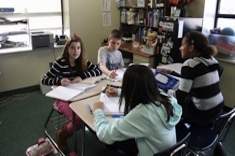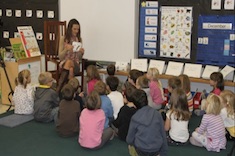Years ago, I was sitting in a workshop led by Debbie Miller as she talked about the importance of reading aloud to students. Of course I already knew the importance of this, but I was struck when Debbie talked about actual numbers. She shared that on a great day at the beginning of the year, she would read more than 20 books to her first graders.
It was hard to fathom reading that many books. As we all stared wide-eyed, she explained that she fit them into any nook and cranny of time possible throughout the day—after lunch, before lunch, during transitions, and so on. She suggested starting with a stack each morning and trying to get through all of them in the day. Debbie said a reasonable goal was 8–10 books a day at the beginning of the school year.
I learned a lot that day with Debbie Miller, and the read aloud piece was a big part of it. I went back to my first-grade classroom with a goal of drastically increasing the number of read alouds. I took her suggestion and prepared a stack each morning to help me reach my goal. I also redefined read aloud for myself and changed my thought that read aloud always needed to be at the carpet with the children gathered around my feet. Over the years my number of read alouds has increased and they’ve become part of my daily routine, sprinkled into all parts and settings of the day.
Earlier this year a colleague asked about my read alouds in September. She asked how and where I fit them into my day, how I chose the titles, and where the books went after they were read aloud. “Specifically, what are you reading this month [September]?” she asked. It has become such a routine for me that I take it for granted. It was a great opportunity to reflect on my day with Debbie Miller, my personal journey with read alouds, and how I choose my read alouds each month. I have indeed increased the number of books, and find it beneficial in many ways:
-
It lets my students know about the variety of books available to them in my classroom library and keeps it fresh throughout the year.
-
It gives us time to enjoy a text before diving back into it as a mentor for reading or writing.
-
It celebrates the time of year and the seasons.
-
It celebrates reading and my love of books, and makes book love contagious.
Books to Include in Read-Aloud Stacks
Author-study books: Each month I have a featured author. I read aloud as many of his or her books as I can. We learn about the author’s life, and at the end of the month we make a poster about what we notice about the author’s style and post it in the author-study portion of my classroom library. In September, Kevin Henkes is my featured author. We love reading his mouse stories about friendship and school. We also read his newer titles, such as Old Bear, Little White Rabbit, and Waiting.
Books that reflect the variety in my classroom library: I need students to know right away what my classroom library has to offer. I select some of my favorite titles from bins throughout my library—nonfiction, fiction, fairy tales, picture books, series such as Henry and Mudge and Poppleton, and lots of early readers. Throughout the year this encourages my students to choose from different parts of the library.
Beginning level books: In the first weeks of school I teach students that during independent reading time they have three reading options: reading the pictures, reading the words, or retelling the story. To do this independent reading, I need my students to know what is available to them at their varying reading levels. I am sure to read aloud picture books that are accessible to all my readers and that will work for all the reading options. Some of my favorites are Up! Tall! and High!, Silly Sally, Rosie’s Walk, and Three Billy Goats Gruff.
Wordless books: I love my wordless-picture-book bin and am delighted with the titles I’ve collected throughout the years. I make sure to read many of them aloud so that my students know how to read a wordless book, and I model the thinking that goes along with this type of reading. Some of my favorites are Float, The Girl and the Bicycle, and Pancakes for Breakfast.
Little Books: My leveled library of little readers in my classroom features titles I’ve collected from Pioneer Valley Books, Mary Ruth Books, Brand New Readers, and more. Although they are leveled texts, they are fun stories with fun characters. I want to make sure that there is excitement about reading these books, so I read them aloud as I would any book. I read level A–C books with the same excitement as higher-level books, laughing at the characters, predicting what will happen, making connections and inferences. Some of my favorites are Big Pig and Little Pig, Piggy and Dad (Brand New Readers), the Danny series (Mary Ruth Books), and the Bella and Rosie series (Pioneer Valley Books).
Books about friendship, manners, and kindness: As I’m building community at the start of the year, I read aloud lots of books with specific lessons around friendship, kindness, and manners. We talk about them and sometimes reread them the next day to talk more about them. Some of my favorites are Rude Cakes, The Story of Fish and Snail, I Can Help, and Duck & Goose.
Seasonal books: A section of my library rotates with each month, featuring seasonal books. In September these books will include topics such as the start of the school year and apples!
Books that I have just because I love them: I have many books just because I love them. Not all of them fit into a reading category or a certain time of year. I sprinkle these books throughout the year, starting in September.
Books that I will be using as mentor texts in reading or writing lessons: I often read aloud books that I’m going to use in reading and writing lessons the next day. I want students to have the opportunity to hear the stories for enjoyment and have time to think about them before I reread the whole book, or just a section, for a lesson.
Newly released books: Of course I’m always watching for new releases by my favorite authors on favorite topics, or books that are getting a lot of attention on my favorite teacher blogs. I love sharing these as I collect them, and students help me decide what we think of them as a community.
I love that when we have a day with few read alouds, my students notice and ask when we are reading more. I don’t think I’ve ever made it to 20 read alouds in a day, but I’m consistently in the 6–10 range. Here is a short video of a read aloud of Roxaboxen during a morning snack break in early October:

The consistency pays off . . . My students’ knowledge about books and authors, their thinking about their reading, and their all-around love of books is evident to everyone around us.
Sample read aloud stack for a day in September:
-
books about manners and friendships (Rude Cakes, You Will Be My Friend!)
-
a book that I will use in a community-building lesson the next day (Duck & Goose)
-
an almost wordless book (Wait)
-
a fun interactive book (Press Here)
-
a writing workshop book (Ralph Tells a Story)
-
a Kevin Henkes author-study book (Sheila Rae, the Brave)
-
leveled books from my Little Books library (Piggy and Dad and Get Down Danny)
Sample read aloud stack for a day in November:
-
a Mo Willems author-study book (Leonardo, the Terrible Monster)
-
a seasonal book (Turkey Trouble)
-
a book that I’ll use in a reading lesson the next day (Roxaboxen)
-
a friendship story reread (The Story of Fish and Snail)
-
a pattern book that we read chorally (Silly Sally)
-
an early reader (Don’t Throw It to Mo!)
-
a book to introduce a series (What This Story Needs Is a Pig in a Wig)
-
a beginning level book with text accessible to most students in my room (The Watermelon Seed)









